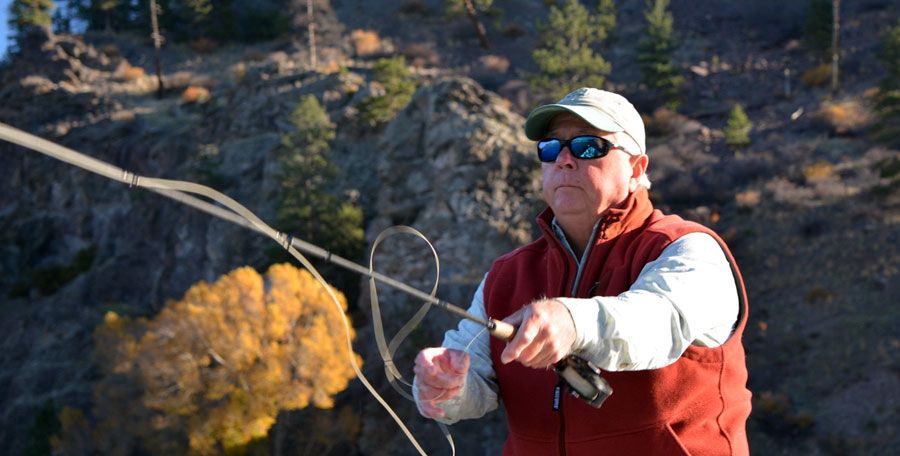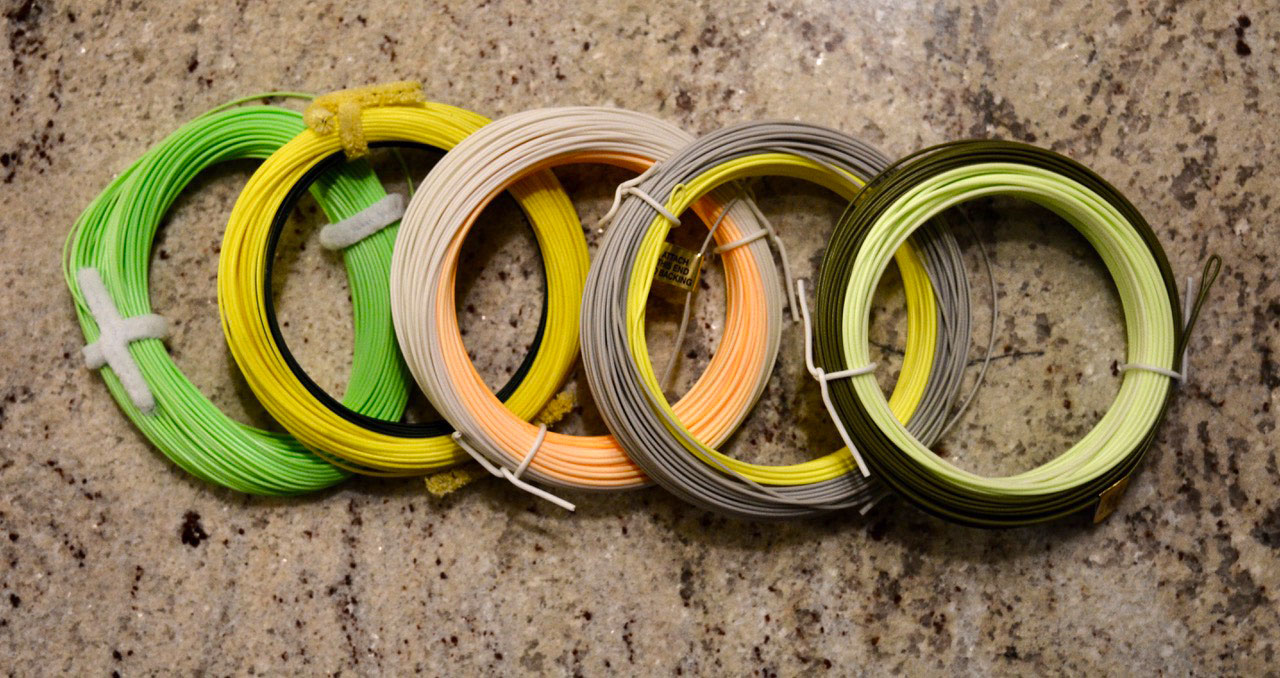Southwestern Montana's Premier Fly Fishing Guide Service
Email Us Call now: 406-580-6050
Understanding Almost Everything About Fly Lines

Many people ask me many different questions about which type of fly lines should they be using, what is the best color for a fly line, which fly line should you choose and how do you clean your fly line? All these questions will be answered here.
What are the different types of fly lines?
Fly lines are very important piece of equipment and good fly lines do make a difference to improving your fly casting game. There are two different types of fly lines for freshwater fishing. The most popular is a floating line, the other is a sinking line. Both will be discussed below.
Floating lines come in two different tapers, Weight forward (WF) and double taper (DT). the two different types of lines have slightly different types of tapers to them. Weight forward lines have a longer belly and a slightly heavier tip or head. This aids in casting in the wind and making longer casts. Double taper lines are the exact same tapers on each end of the line and they tend to have a shorter belly and tip/head. They are good for casting more precise shorter distances. One of the main advantages of a double taper line is that once one end needs to be replaced, you can just reverse the line and you will have a brand new end to work with. With the forward taper lines, once it starts to crack or lose it float ability, it’s time to replace the entire line. Weight forward lines are easier to cast when nymphing, throwing larger flies or when casting in windy areas. Double taper lines are best for casting shorter distances, smaller flies and less windy situations.

There are many different types of sinking lines. As the name implies sinking lines do not float on the waters surface but sink at various rates. You can purchase different types of sinking lines that sink at various depths. They also make a variety of “sink tips” that are a hybrid between floating lines and sinking lines. The tip of the fly lines sink at various rates, while the running line floats on the surface.
Both types of fly lines are used for various different fly fishing strategies. Depending in your strategy and type of water you are fishing will determine which line you will want to use. For instance if you are fishing a lake and want to strip a leech or damselfly nymph off the bottom, you would be best served with a sinking line and slow retrieve. If you wanted to throw grasshoppers off the grassy bank of a river, you would want to use a floating line.
Personally, I fish weight forward fly lines exclusively for 95% of the fishing that I do in the Rockies. Here in the West, we have big rivers and can have big wind. We fish many big foam flies and heavy nymph rigs and I have found that weight forward fly lines perform better for me. The other 5% of the time is usually in the fall when stripping streamers for those aggressive brown trout and I have a full sink line for deep water and a sink tip for faster shallow waters. Each are spooled up on additional reels that can be switched out rather quickly. If you were to fish spring creeks or other delicate waters I would suggest a double taper fly line. They do make it easier to gently land a small dry or light nymph rig on these types of waters.
What weight of fly line do I need?
In fly fishing, you want to match your line weight to your rods specific weight. There are many different lengths and weights of rods to match a variety of fishing. You may see some markings above the cork on your handle that will tell you all you need to know. Different rod companies use different codes, but most are easily readable. Sage rods for instance label their rods 690-4 or 586-3. What this means is that the first rod is a six weight, 9’ rod in four pieces. The next rod is a five weight, 8’6 three piece rod. Different companies us a slightly different system, but most will give you the weight of the rod, the length and then how many pieces the rod is.
You will want to use a 6 weight line with a six weight rod, you do not want to under line the rod. Meaning, you don’t want to put a five weight line on a six weight rod, or a four weight line on a five weight rod.
You can over line rod in some cases. For all intents and purposes a six weight will work well on a five weight rod. Many of today’s fast actions rods work better with a heavier line on them as they help “load” the rod of stiffer/faster action rods. If you have a newer high dollar rod that just isn’t working well for you, I suggest trying to put one size larger fly line on the rod and see if that improves it performance.

Does the color of the fly line matter?
Fly lines come in a variety of colors and over the years I have seen many different colors of fly lines. Everything from North Carolina Blue to bright orange and many other colors in-between. Personally I like my fly line to be a darker green or olive drab color. Something that won’t be a contrast to the water. I have used bright yellow fly lines with success, and for a novice angler some of the brighter lines may aid you to see your fly on the waters surface. I believe that if you are fishing very fast broken water the fish don’t worry too much about the color of the fly line, but if you were fishing slow moving water with wary trout, a bright fly line probably isn’t going to be advantageous. You need all the help you can get when fishing spring creek like waters with spooky trout and a more camouflage line you have, that’s one last thing to spook your quarry. I have heard more than once that the guides in New Zealand take their clients fly lines and dye them the night before to a more neutral color. New Zealand trout are known for there spookiness and difficulty to catch. Bright fly lines or definitely a no go south of the equator for freshwater fishing. Recently, many fly line companies have been making there lines a little less neon like and more in the drab natural color’s.
How to clean your floating fly lines and get the most out of it.
Fly lines will after time get dirty and grungy and need to be cleaned to keep from drying, cracking and sinking. With some regular maintenance you can get the most our of your fly lines. Depending on how much you fish will determine how often you will need to clean your line. Those who find themselves on the water over 25 days a year should clean your line at least twice if not three times a year. If you only fish very few days a season, once a year may be all you need.
The easiest way to clean your fly line is with some store bought fly line cleaner and either an old shirt or some sort of felt box designed for cleaning lines. I generally pull off the first 30-40 feet of colored fly line and then squirt a liberal amount of fly line cleaner into the felt and run it up and down the line three or four times. The felt does a great job of pulling the dirt off the line and you should be left with a clean, well conditioned line. Spending 5-10 minutes cleaning your line will greatly help your lines cast easily and float higher.
If it’s the end of the year and you want to give your lines a deep cleaning, the bucket method is a great way to clean your entire line. Basically, you have two buckets or you can use your kitchen sink, fill one bucket with a small amount of mild detergent and warm water and the other with just warm water. Strip off the fly line from the reel and try to make big loops in the sink or bucket. You can strip off all the line off the reel or just the distance you usually use. As mentioned you want to have big loops in the wash bucket. Otherwise, you may find yourself trying to undo a major tangle. After letting the line soak for about 10-15 minutes, take a rag or paper towel and run the line through the rag as you transfer it into the rinse bucket. Let it sit in the warm clear water for a few minutes, repeat running the line through the rag again and then apply some line conditioner to your newly cleaned fly line and reel up your freshly cleaned fly line.
Watch the video: https://www.rioproducts.com/learn/cleaning-a-fly-line-part-1
Book Your Fly Fishing Trip Today!
Why Choose Us
| Professional Guides Licensed, trained, and experienced. |
|
| Enjoyable & Memorable Satisfaction is our top priority. |
|
| All Inclusive We'll provide everything you need. |
Connect With Us
Get Updates
- Copyright © 2023 Montana Trout Wranglers | Website Design, Development & Support: PowerPro Live